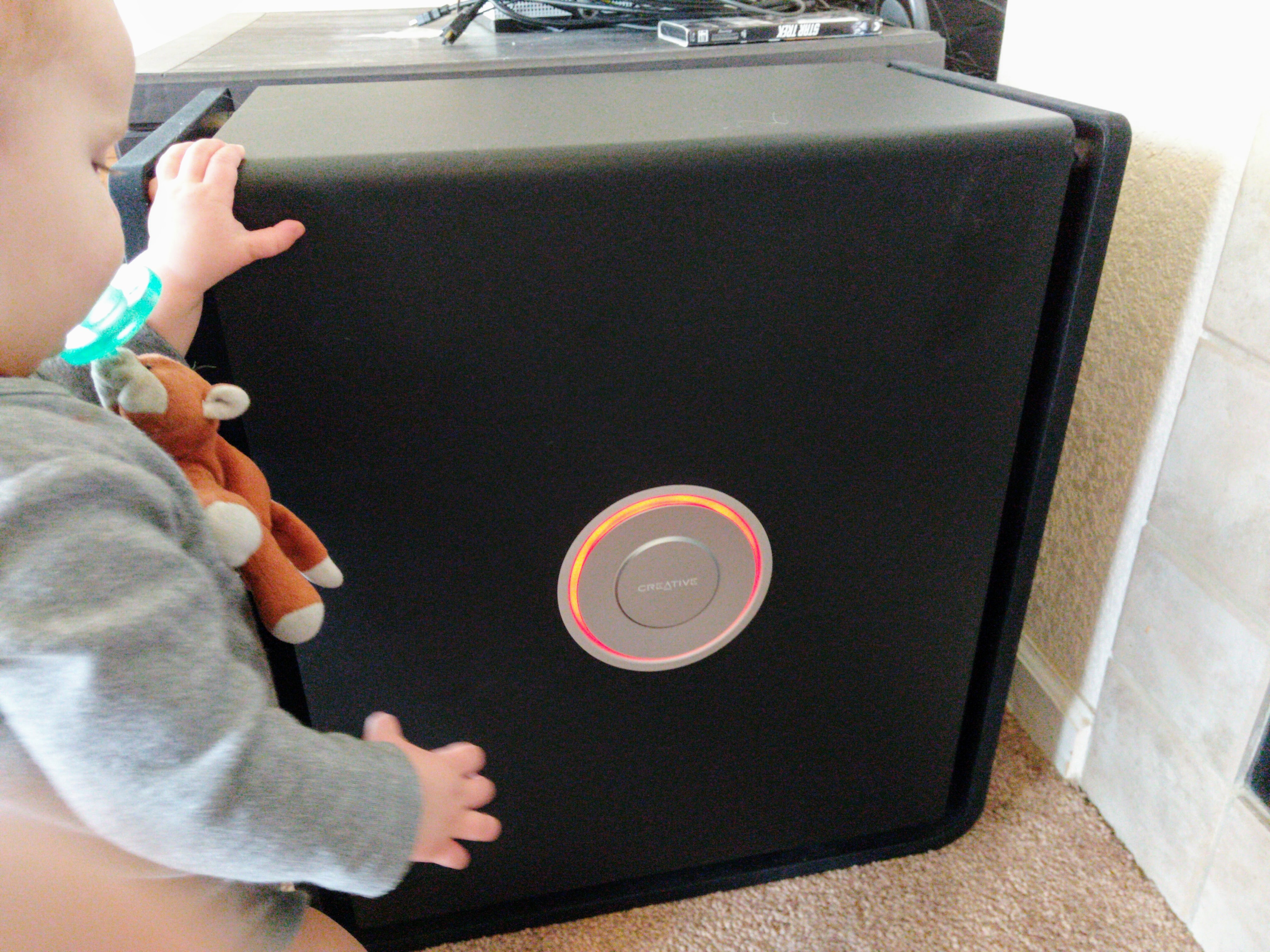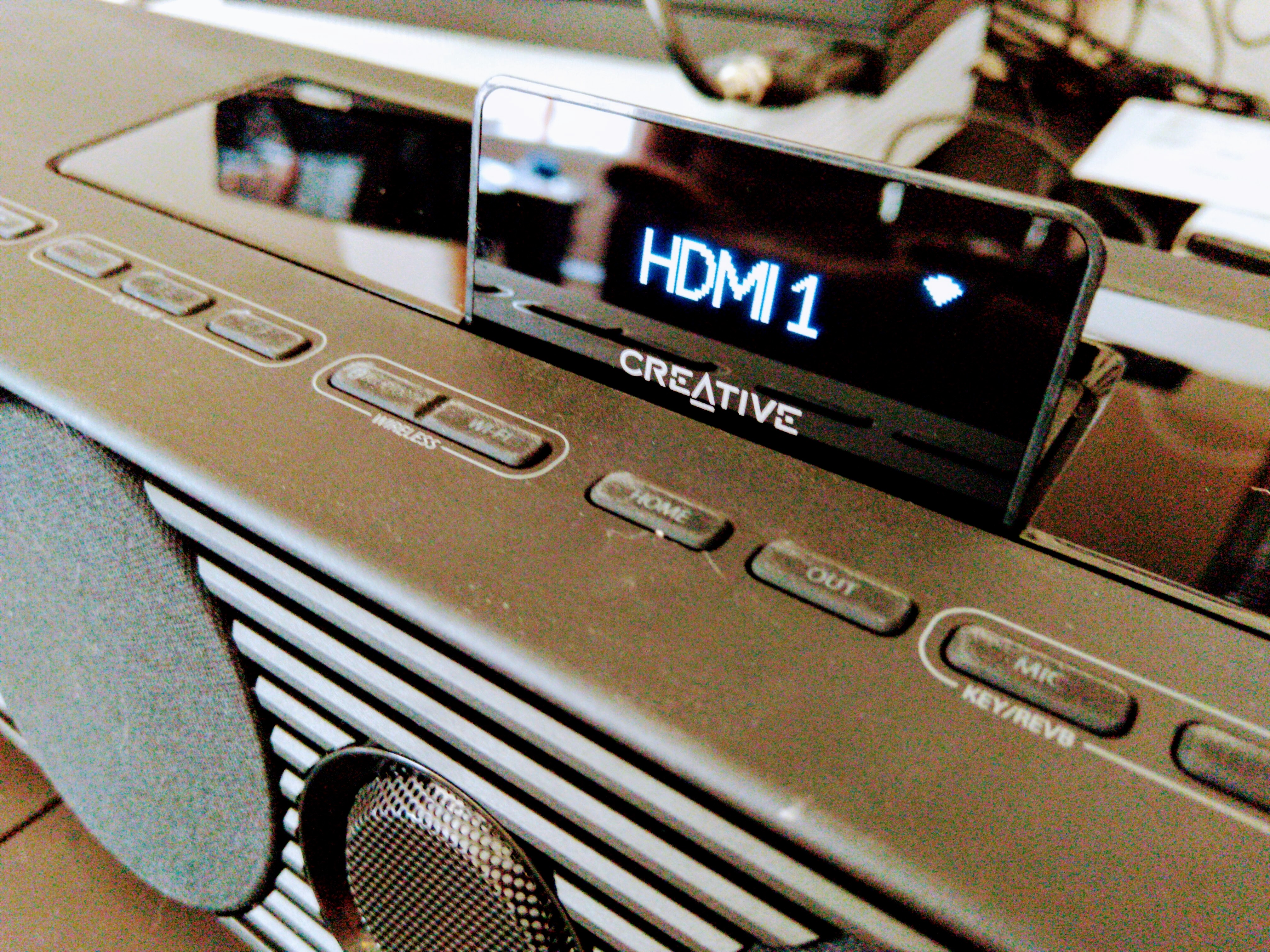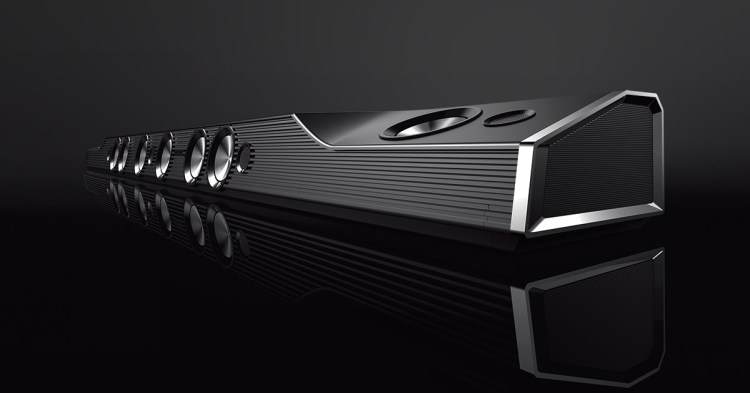I am ruined for headsets, soundbars, and most surround sound systems. I now know what it’s like to play my games with an earth-shattering, movie-theater-quality audio system. Nothing else will do. The X-Fi Sonic Carrier from Creative has made everything else sound cheap and hollow by comparison. And it had to change me forever to justify its $4,000 price — that’s more than what my car is worth.
The Sonic Carrier is shipping now, and that price is actually down from the $5,800 that it debuted at earlier this year. For that money you get a soundbar and a subwoofer — although calling the Sonic Carrier a “soundbar” is a crime of inadequacy.
It boosts 1,000 watts of speaker power, and that does not include the 600 watts for the subwoofer. It has eight distinct processors that send audio to nine front-firing speakers, four up-firing channels, and two more that fire to the side. On top of that, the Sonic Carrier has a 64-bit quad-core Android system inside of it that can process 4K Ultra HD HDR video at 60 frames per second.
But while all those specs are nice on paper, the viability of the Sonic Carrier comes down to one question: Is it worth the money? And I’m stunned because it is.
June 5th: The AI Audit in NYC
Join us next week in NYC to engage with top executive leaders, delving into strategies for auditing AI models to ensure fairness, optimal performance, and ethical compliance across diverse organizations. Secure your attendance for this exclusive invite-only event.
This is the king (and the future) of soundbars.
What you’ll like
Cinematic sound
The Sonic Carrier turns your home into a movie theater. That’s the easiest way to put it. All of that power and all of those speakers work together to bring whatever audio source you feed into it to life like you’ve rarely heard before.
In a game like Assassin’s Creed: Origins with Dolby Atmos, every detail came through the speakers with ear-tingling clarity. Thanks to the side- and up-firing speakers, my entire room filled with ambient noises or the sound of a metal blade slicing through armor.
A movie like Star Wars: The Last Jedi demonstrates how capable the Sonic Carrier is at going from quiet and tense moments to all-out bombast. In one moment, Kylo Ren is explaining something quietly to Rey, and the carrier handles their voices with precision and clarity. But in the next moment, Luke is attacking him with a lightsaber, and Kylo pulls a building down on top of them. And the carrier handles going from one extreme to the other flawlessly. It can take you from a conversation to overwhelming you with house-shaking bass that still has all of the detail of the on-screen action. Your room doesn’t just rumble, you can hear and feel the bricks crashing into the camera.

Above: Human child for scale.
The virtualized surround sound is also amazing. My family room has two story-high vaulted ceiling, which is a problem because it’s taller than what Creative recommends for its 7.1 Dolby Surround sound. But even in this setting, I still get that 360-degree-like audio. This is not a replacement for a full surround system, but it gets close to that setup — especially in terms of playing Dolby Atmos content. That object-based audio tech makes overhead audio from the ships in Star Trek (2009) or the rockets on Phara’s back buzz through the top of your entertainment room with a stunning sense of place.
But beyond surround sound and Dolby Atmos content like Assassin’s Creed or Star Wars, Sonic Carrier is perhaps most impressive because of how well it handles YouTube and other low-fidelity sources. Thanks to Creative’s SuperWide X-Fi audio algorithm and its EAX 15.2 digital signal processor (DSP) alchemy, the Carrier can turn a crappy source like a movie trailer on YouTube into an immersive, consuming soundstage that blasts Dolby/DTS-like audio at a 24-bit 192kHz resolution. It’s an astonishing technology that works better than you can imagine.
Vocal clarity
One aspect of the sound that I want to emphasize is how the Sonic Carrier handles dialogue. Maybe I’m weird, but for a lot of movies, television, and games, I babysit the remote control. I want to turn up the dialogue sequences and turn down the action because the talking is too quiet and the bombast is way too loud.
The Sonic Carrier has eliminated this problem for me.
The Carrier has a ton of preset audio-processing modes, and they all handle the transition from quiet dialogue to loud dramatic music or concussive explosions well. A character talking will come through loud and crisp, and then an explosion could kill them without somehow ripping the ears off of your skull.
But this even works for awful audio mixes. The absurd Nic Cage film Vampire’s Kiss has one of the worst audio tracks I’ve ever heard. Dialogue is muffled and inaudible, and then music is screeching and piercing. But by turning on the Sonic Carrier’s X-Fi Dialogue mode, the problem almost went away. I was able to improve it even more by turning up the volume a little higher and then engaging the Night Mode option, which limits the range between the quietest and loudest moments so you can watch while a baby or a significant other is sleeping.
I can’t tell you how much nicer it is to watch and play without having to ride the volume rocker the entire time.
Powerful, simple to set up, and easy to use
The primary benefit of a soundbar is that they are easy to set up, and this holds true for the Sonic Carrier. Everything just works. The system has four HDMI ports and one HDMI-Out that is capable of handling audio-return channel (ARC) from a capable television. It also has two optical ports, RCA, an ethernet port, SD card ports, USB, and even two microphone jacks so you can use it as a public-address system.
That may seem like an overwhelming number of inputs and outputs, but Creative has done the work to ensure that you shouldn’t have to fiddle with the Carrier to get it working. Plug the HDMI-out in the ARC HDMI port on your TV, and you’re ready to go. You can now get any content through your TV onto the soundbar or from the Carrier onto the TV. And it should all work in 4K, 60Hz, and HDR — the Carrier is not going to strip anything from your console or PC on the way to your display.
If you want to use the Carrier itself as the content source, that can work. The Android unit inside of the Carrier has full access to the Google Play app market, so you can download Netflix, Hulu, Plex, and more and run them all directly from speaker unit. It’s an easy way to turn any TV into a smart TV.
Sturdy and future-proof
Creative built the Sonic Carrier out of high-quality materials like CNC aluminium. It feels expensive to the touch, but it’s not fragile. An example of this is the digital display that folds out of the top of the unit on a hinge. That isn’t flimsy or weak, and you could open and close it repeatedly without breaking it.
I also like the visual design of the Carrier. It is not going to blend in with your entertainment center, but it sticks out in a way that draws attention to just how many speakers are firing sound at your and any company you may have joining you.
As for the internals, the device has everything it needs to handle any coming standard changes without going obsolete. The HDMI for example is 2.0a with HDCP 2.2, and Creative is promising ongoing software/firmware updates in case it needs to modify anything to work with some new device from Vizio or TCL or any other vendor.

Above: The LCD display on the Sonic Carrier.
What you won’t like
It’s expensive
You can’t get around $4,000. If you experienced the Sonic Carrier in person without knowing that price, and then someone whispered it in your ear, I wouldn’t blame you if you wordlessly walked out of the store.
And even though it earns that price with its quality, the problem is that it doesn’t exist in a vacuum — and we all have Google. We can all get online and start comparing prices for 5.1 or 7.1 surround systems with dedicated audio receivers. And sure, they’re harder to setup and may not have all of the same features, but they cost half or a third of the price. If you want major features like Dolby Atmos and 4K 60hz HDR support, though, you could end up paying more than $4,000. So that price isn’t just some boutique number pulled out of nowhere — it’s standard for the technology. Regardless, that’s a big number.
No DTS … yet
The only other major drawback is that the Sonic Carrier does not work with the DTS encoder. Creative is working on bringing DTS:X (the DTS equivalent of Dolby Atmos positional audio) soon through an update, but that isn’t due out until later this year.
Once that update is live, I expect it to work well. Atmos content pops to life on the Sonic Carrier even if the virtualized surround isn’t always perfect. DTS:X should have similar performance — although it wouldn’t shock me if it does reproduce better sound on the height channels than Atmos.
Conclusion
Creative’s X-Fi Sonic Carrier is expensive, but it does so much to justify its price. It reminds me of a Pioneer SX-828 or a Marantz 2270 — classic pieces of audio equipment from the 1970s that people still pay hundreds of dollars for today. Even more than television, audio systems are not something you should want to replace every year or even every few years. If you invest your money wisely, it should last — and the Sonic Carrier is going to last.
As for how it works as a home theater, I’m in love. In every real-world scenario, it blew me away. It made casually watching television a joy with its clear dialogue reproduction. In serious movie-watching mode, it turned my home into a Dolby movie theater. Goofing around on YouTube has never sounded better. Watching some late-night Twitch in Night mode ensured I could hear the broadcaster without waking up my family. As a music player, I’ve never heard “Hey Nineteen” by Steely Dan like this before.
And the Sonic Carrier still has so many things that I haven’t taken advantage of. I would have loved to try the PA mode with a microphone for some at-home karaoke. It’s such a versatile piece of technology — a king of all trades.
Finally, the Sonic Carrier is a glimpse into the future. Creative is going to spend the next few years making this technology smaller and less expensive, and that’s exciting. SuperWide X-Fi alone is something to look forward to. If it starts sneaking into more affordable products, it is going to shake up the home-audio market.
And if you want to experience the best soundbar from five years in the future right now, you can get the Sonic Carrier and enjoy.
The X-Fi Sonic Carrier is available now for $4,000. Creative provided GamesBeat with a sample unit for the purpose of this review.


